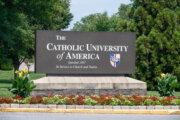If you’ve noticed that a lot of doctors have names and accents that seem to have originated in places beyond the shores of these United States, you’re not alone. According to 2017 data from the Association of American Medical Colleges, 24.3 percent of all doctors practicing in the United States were trained abroad before coming to practice in the America.
While physicians educated abroad are common here, it’s no easy task to become a practicing physician in America. Even though immigrants may have received excellent training and education in their home countries, they must clear additional training and licensing hurdles to practice in the U.S.
[See: 10 Lessons From Empowered Patients.]
Foreign doctors arriving in the U.S. begin the process by applying for a certificate from the Educational Commission for Foreign Medical Graduates. The certificate verifies the doctor’s training and practice record back home and determines whether the doctor is ready to enter a residency program in the U.S. “After ECFMG certification, physicians who wish to practice medicine in the United States must complete an accredited residency training program in the United States or Canada,” even if they’ve already completed an equivalent level of training in their home country, says Dr. Lawrence Braud, an ear, nose and throat specialist in private practice in Baton Rouge, Louisiana, and vice president and chair of the private practice subcommittee of the Physicians Foundation, a nonprofit that supports physicians. “This process will take at least three years. The physician will have to complete a residency program regardless of the training they have received overseas.” They must also complete a gauntlet of testing and paperwork to meet all the requirements of the programs.
And none of it’s cheap. The ECFMG certificate is one of the less expensive items on the list at $75. One exam costs $1,565, another $910. Still, many doctors brave the challenges; in 2017, 9,839 foreign-educated physicians applied for an ECFMG. But only a fraction of them will end up practicing in the United States, tripped up by one of the many obstacles in their way, which range from financial (how many immigrants fleeing civil war in their home countries have the several thousand dollars required to register for the necessary exams?) to language and culture.
But in some cases, those cultural and language differences could turn into an opportunity. That’s the approach of UCLA Health’s International Medical Graduate Program which seeks to place native Spanish-speaking doctors in primary care roles across California to alleviate the shortage of doctors and provide care for the 4.5 million Spanish-speaking people living in medically underserved areas in the state. The program aims to stop so-called “brain waste” — the underemployment of foreign-trained physicians who immigrated to the U.S. legally but haven’t yet achieved the necessary licensing to practice in the U.S. — while simultaneously filling a need in the community.
Dr. Michelle A. Bholat, professor and executive vice chair of UCLA’s department of family medicine and executive director of the International Medical Graduate Program at UCLA Health, says that when she was launching the IMG program, the key was to find a university that would partner with her so that medical professionals could get the training they needed. UCLA hosted the program, which is grant-funded through private foundations, and since its inception in 2006, 128 doctors have participated.
In exchange for a monthly stipend and training, which lasts from six to 24 months and includes exam prep and helping physicians navigate the complicated world of placement in a residency program, physicians must commit to practicing medicine in a specifically designated underserved community in California for two to three years. The idea was to match doctors with critical language skills and cultural knowledge with the communities that need them most. “Thirty-nine percent of the population in California is Latino, but less than 4 percent of licensed doctors are Latino, and we’ve got these areas of unmet need,” Bholat says.
Some of the physicians who’ve entered the IMG program are still in residency and have not yet fulfilled their commitment. But the key figure Bholat cites in discussions of the success of the program is what happens after physicians meet those requirements. “Of all the individuals who have graduated from our program, who could go work wherever they wanted to after meeting their requirements, 75 percent of them remained in the underserved communities.”
While programs like UCLA’s IMG are leveraging the foreign-trained physician workforce to address critical doctor shortages in areas that need them in the U.S., one that’s often cited in discussions of using this workforce to alleviate the doctor shortge here is that this can set up a sort of “brain drain” that could entice physicians away from their home countires to practice here. The fact remains, there’s a real need for well-trained doctors in communities all around the globe, and making sure that people in other countries have access to high quality health care is important, too. This is one of the underlying philosophies behind Memorial Sloan Kettering Cancer Center‘s international programming, which brings international doctors to the United States for fellowships, often with the intention that they will not settle here, but rather go back to their native countries and elevate the level of practice there.
[See: 14 Things You Didn’t Know About Nurses.]
Dr. Murray F. Brennan, an oncologic surgical scientist and vice president for international programs at MSKCC, says that for some doctors, moving to the United States and setting up a practice is a means of “economic escape” from a low- or middle-income country where there would be fewer opportunities to earn a good living. While this might make a small dent in our own need for doctors in the U.S., this supply-and-demand situation could create an unfair shortage of doctors in some countries that can hardly spare a good doctor. “The unfortunate thing is, this means that we tend to steal from the countries that can least afford to lose [doctors],” Brennan says. “High-income countries, like in Europe, they can absorb the loss of people. But a low-income country like in sub-Saharan Africa, they really can’t.”
Brennan, who is himself an immigrant from New Zealand, arrived in the U.S. 38 years ago for medical school and decided to stay. “I came for the education and I stayed because I was in an intellectual candy store. The education was great and it allowed me to grow in a way I couldn’t possibly have grown in New Zealand,” he says. Although he didn’t personally return to practice in New Zealand, he has helped train many other doctors who have gone home to improve medicine in their own countries. (For his efforts, in 2015, he was appointed by Her Majesty the Queen as Knight Grand Companion of the New Zealand Order of Merit, and yes, he carries the title “Sir.”)
One of the beneficiaries of Brennan’s international programming is Dr. Olusegun “Isaac” Alatise, a surgical gastroenterologist and oncologist, who read an article in 2010 that Brennan had authored. “The article was all about training — the need to train surgeons in developing countries, and [that] they should be able to get similar results [to those achieved in America] in pancreatic surgery if they are properly trained,” a concept that resonated with Alatise who trained and worked in Nigeria. So he contacted Brennan who informed Alatise of a three-month “observership” training opportunity at MSK. Alatise applied because “I’ve always been interested in seeing what people do outside the country. Not because I want to move, but so I can improve what we’re doing locally and then take the landscape of medicine to a higher level,” he says.
Alatise got in, and while at MSK for the program, he met Dr. T. Peter Kingham, an American surgeon who was just completing his own fellowship at MSK. “I’d been doing work in West Africa for 10 years prior, and so we were an obvious match and we hit it off right away,” Kingham says. The two began collaborating to close the cancer disparities gap between the U.S. and Nigeria, and before long had built a data collection program called the Africa Research Group for Oncology, which has grown to include 10 institutions in Nigeria and two in the United States. Although the program is still quite new, Alatise and Kingham say it’s already yielded actionable information about risk factors and how patients are likely to respond to treatment. “It’s very novel because prospective data like that is very rare in sub-Saharan Africa,” Kingham says.
In addition, “since we started in 2010, besides the studies that we’ve been doing, the surgical approach to cancer has changed in Nigeria,” Alatise says. “My hospital is now regarded as the site of excellence in colorectal cancer because the quality of surgery has improved. The quality of cancer care has also improved.” Alatise and Kingham hope to expand the effort into a comprehensive cancer research and training group that will work with many more hospitals and health centers across sub-Saharan Africa.
The African initiative is a prime example of what Brennan says is the whole point of the international programming he runs at MSK, for which participants are carefully selected. “These are the brightest and the best from other countries. We almost always select people who are going to make a difference when they return.” Admittedly, this goal is sometimes limited by language; Brennan says the program obviously has a bias towards English-speaking doctors. “That’s what makes it easier for people from India and Kenya [to participate] than for people from China.”
[See: 10 Questions Doctors Wish Their Patients Would Ask.]
Still, he says improving access to health care and elevating the quality of that care around the world remains a worthy intellectual challenge and a work in progress. “I think we should be having the brightest and the best coming [to the U.S.] at an advanced stage, either because they’re better than we are and I want them here, or they’re equivalent to [American doctors] and we can make them better and then they go back. It’s not helpful to take people from low- and middle-income countries whose only goal is eventually, ‘I’ll be an ophthalmologist and I’ll make enough money.'” Rather, he says it’s preferable if these doctors learn well then pay that forward by creating better health opportunities at home and by helping the next generation of doctors. “I do think we should go there and make a difference. I do think we should give back,” he says.
While this could seem like good resources are going to Africa when we can’t spare them either, the fact is, programs like this are increasing our fundamental understanding of diseases and how they move through populations. That knowledge will likely eventually come back around to inform practice here, and so the cycle goes. It’s a small global village, after all, and elevating practice in one part of the world can pay dividends elsewhere.
More from U.S. News
10 Questions Doctors Wish Their Patients Would Ask
14 Things You Didn’t Know About Nurses
10 Lessons From Empowered Patients
How International Doctors Can Help American Patients originally appeared on usnews.com







